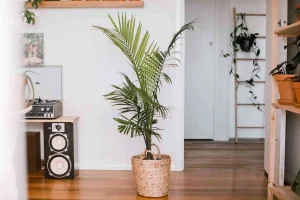Welcome to our complete guide on growing and caring for the majesty palm plant. Whether a seasoned gardener or a beginner, this article will provide all the information you need to grow this beautiful indoor plant successfully. We will cover everything from the basics of majesty palm to its care requirements and joint problems. So, let’s get started!

Introduction to Majesty Palm Tree
What is a Majesty Palm?
Majesty palm, scientifically known as Ravenea rivularis, is a famous palm tree that is often grown as an indoor plant. Native to the Madagascar rainforest, this tropical plant has gained popularity for its lush green fronds and attractive arching growth habit. With its resemblance to the Kentia palm, the majesty palm adds a touch of exotic beauty to any indoor space.
Types of Majesty Palm
Several varieties of majesty palms are available in the market, each with unique characteristics. Some popular types include the dwarf majesty palm and the silver palm. The dwarf majesty palm is a smaller version of the traditional majesty palm, making it suitable for smaller indoor spaces. On the other hand, the silver palm has silvery foliage that adds a touch of elegance to any room.
Majesty Palm Care
Light Requirements
Regarding light requirements, majesty palms thrive in bright, indirect light. They prefer to be placed near a window to receive filtered sunlight. However, it is essential to avoid placing them in direct sunlight as it can scorch their leaves.
Water Requirements
Majesty palms require regular watering to keep their soil evenly moist. During the growing season, water the plant thoroughly, allowing the water to drain out of the pot. However, ensure not to overwater, which can lead to root rot. Reduce the watering frequency in winter but never let the soil completely dry out.
Humidity Preference
Being native to tropical regions, majesty palms prefer high-humidity environments. To create the ideal growing conditions, placing a humidifier near the plant or mist its leaves regularly is recommended. This will help to replicate its natural habitat and promote healthy growth.
Temperature Preference
Majesty’s palms are grown in warm conditions, ranging between 65-85°F (18-29°C). They can tolerate slightly cooler temperatures, but keeping them away from drafts or cold windows is best. Avoid exposing the plant to temperatures below 55°F (13°C) as it can cause damage to its foliage.
Soil Requirements
When it comes to soil, palms are acid-loving plants, those that prefer a soil pH below 7. They also thrive in well-draining potting soil that retains moisture without becoming waterlogged. A mix of peat moss, perlite, and sand can provide the ideal growing medium for these plants. Avoid using heavy clayey soil, as it can lead to drainage issues.
Fertilizer Requirements
Majesty palms benefit from regular fertilization during the growing season. Feed them a balanced liquid fertilizer every 2-3 weeks to provide the nutrients for healthy growth. However, be careful not to overfertilize, as it can burn the plant’s roots. Always follow the instructions on the fertilizer package for the correct dosage.

Majesty Palm Grow
Here are the steps to follow to plant your majesty palm soil:
Step 1: Select the appropriate pot
Even if the soil is well-draining, your majesty palm’s roots can still suffer from root rot if the pot does not have proper drainage. Choosing a pot with a single large hole at the bottom is recommended. Additionally, it is crucial to use a clean pot to avoid the risk of transferring bacteria or other harmful pathogens to your majesty palm.
Tip: Ensure you include a drainage tray with elevated feet at the bottom to protect your floor or furniture.
Step 2: Place your majestic palm in the pot
Start by placing a small amount of your designated soil mix for the majestic palm at the bottom of the pot. Carefully remove the majestic palm from its current container and trim any decaying roots. Next, position the majestic palm upright at the center of the pot and fill in the space on the sides with the potting mix. Lastly, add a mixture layer on top of the root ball, leaving approximately two inches of space at the top.
Step 3: Water thoroughly
Thoroughly water your palm and allow it to drain. Either empty the tray right away or let the majestic palm remain in the sink or tub for about an hour or two after watering so the soil can drain thoroughly. If the soil settles, add extra peat and potting mix on top.
Step 4: Apply Fertilizer
In its natural state, the soil is rich in various nutrients that plants require. However, a plant can deplete all these nutrients in a potting mix within a few months. To ensure that your majesty palm gets a continuous supply of necessary nutrients such as magnesium, potassium, and nitrogen, add Indoor Plant Food to its watering routine around a month after potting. Fertilize with each watering during the spring, summer, and fall seasons. During the winter, when the palm’s growth slows down and requires less nutrients, reduce the frequency of fertilizer application.
Step 5: Regularly Aerating the Soil
Over time, the soil in the pot of your mother palm may become compacted, hindering efficient water absorption. If you observe that the soil is not absorbing water as well as it used to, gently create deep holes in the soil using a chopstick or dowel.
Majesty Palm Propagation
Propagation of majesty palms can be tricky and is usually done through division. To propagate a majesty palm, carefully remove the plant from its pot and separate the offshoots or new growths from the main plant. Plant the divisions in separate pots filled with potting soil and provide them with the same care as mature plants. It may take some time for the new plants to establish and grow.
Common Problems Seen With Majesty Palm
Pests
Majesty palms can be prone to pests like spider mites and scale insects. These insect pests can cause damage to the plant’s leaves and overall health. Regularly inspect your palm for any signs of infestation and take appropriate measures to control these pests. Insecticidal soaps or neem oil can be used as effective treatments.
Yellow leaves
Yellow leaves are a common problem seen with majesty palms. This can be caused by overwatering, underwatering, or insufficient light. Adjust the watering schedule and ensure the plant receives enough indirect light to restore its health. Remove any yellow or brown leaves to promote new growth.
Leaf blights/leaf spots
Majesty palms can develop leaf blights or spots often caused by fungal infections. To prevent these issues, avoid overwatering and ensure good air circulation around the plant. If leaf spots appear, carefully remove the affected leaves and apply a fungicide to stop the spread of the infection.
Leaves Turning Brown
Brown leaves in majesty palms can indicate underwatering or low humidity. Ensure to water the plant regularly and increase humidity levels by misting the leaves. If crispy and dry leaves accompany the browning, it may indicate a lack of water. Adjusting these factors can help revive your majesty palm.
Majesty Palm Toxicity
It is important to note that majesty palms are non-toxic to humans and pets. This makes them a safe choice for households with curious children or animals. However, keeping any plant out of reach of pets or small children is always a good practice to prevent accidental ingestion.
FAQ
Q: How do you grow a majesty palm indoors?
A: With a majesty indoor palm, place the plant in a bright area with indirect sunlight. Water the palm regularly to keep the soil moist but not soggy. Provide high humidity by misting the leaves or placing the plant on a humidity tray. Use a well-draining potting mix and fertilize the palm regularly during the growing season.
Q: When should I prune my majesty palm tree?
A: Prune your majesty’s palm tree in spring or early summer. Remove any dead or yellowing fronds by snipping them off at the base. Avoid cutting healthy green fronds, as they are necessary for the plant’s photosynthesis and growth.
Q: Can I grow a majesty palm tree in a pot?
A: You can grow a majesty palm tree in a pot. Choose a pot at least 2-3 times the size of the root ball and has drainage holes at the bottom. Use a well-draining potting mix and ensure the palm has enough space to grow in the pot.
Q: What are common indoor pests that affect majesty palms?
A: Common indoor pests that may affect Majesty Palms include mealybugs and scale insects. These pests can be treated with insecticidal soap or neem oil. It is essential to regularly inspect your palm for signs of infestation and take swift action to prevent further damage.
Q: Can majesty palms be grown indoors or outdoors?
A: Majesty palms can be grown both indoors and outdoor. However, many palms are commonly grown as indoor trees due to their sensitivity to winter air and cold weather. When grown outdoors, they prefer warm conditions with full sunlight.
Q: What do majesty palms need to grow?
A: Majesty palm plants will grow successfully with a few key things, including bright but indirect light, consistently moist soil, high humidity, and regular fertilization. Providing these conditions will help the palm thrive and maintain its attractive appearance.
Q: What is the growth rate of a majesty palm?
A: The growth rate of a majesty palm is typically slow to moderate. Under ideal conditions, it can grow up to 2-3 feet per year. However, the growth rate may vary depending on light, temperature, and overall care.
Q: How should I repot my majesty palm?
A: Repot your majesty palm when it outgrows its current pot or every 2-3 years. Choose a pot that is slightly larger than the current one and has drainage holes. Gently remove the palm from its current pot, loosen the root ball, and place it in the new pot. Fill the gaps with fresh potting mix, water thoroughly, and ensure the palm is stable in its new pot.
Q: Can I grow a majesty palm tree indoors or outdoors?
A: Majesty palms can be grown indoors or outdoors, depending on your climate and space availability. Indoors, they make excellent houseplants and add a touch of tropical elegance to any space. Outdoor plants are suited for tropical or subtropical regions where the temperatures do not drop below freezing.
Q: Is it tricky to grow a majesty palm indoors?
A: While majesty palms can be grown indoors, they can be tricky to care for. They require specific conditions such as bright, indirect light, high humidity, and consistently moist soil. However, they can thrive as attractive indoor plants with proper care and attention to their needs.
